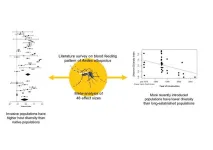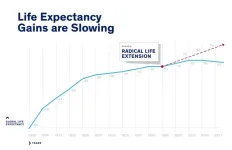(Press-News.org) The European Commission (EC) has released the 10-year assessment of the Human Brain Project (HBP), an EU-Flagship initiative that concluded in 2023. The report was authored by a panel of independent scientific experts. Their assessment of the HBP’s development and results over the full 10 years comes to a strongly positive conclusion. The report highlights that the HBP made major contributions and had a transformative impact on brain research. One of the main outcomes of the HBP is EBRAINS, the open research infrastructure that continues to push neuroscience research forward.
The HBP brought together more than 500 scientists, clinicians and engineers from all over Europe, to establish new ways of studying human brain complexity through advanced computational methods and cutting-edge technologies.
The report highlights notable achievements of the HBP, including leading digital brain atlases, advanced brain simulation platforms across scales, the application of cognitive modelling and personalised medicine, as well as remarkable advances in neuromorphic computing, neuroinspired robotics and AI.
“It was our vision to achieve a change in the way neuroscience is done in the age of digital tools and computing. We are glad to have succeeded in this and that this is now also being recognised from the outside”, says Katrin Amunts. The brain researcher served as Scientific Director of the Human Brain Project from 2016 to 2023 and is currently joint CEO of EBRAINS. “The success of the HBP was only possible due to the work of so many excellent colleagues across Europe over the years.”
“The legacy of the HBP flagship, coupled with the new research infrastructure provided by EBRAINS, will continue to drive advancements in brain health, brain-derived technologies, and collaborative research worldwide”, adds André Syrota, former Chair of the HBP Stakeholder Board and current Chair of the Governing Board of EBRAINS.
MEDIA CONTACT
press@ebrains.eu
Find the full report at:
https://digital-strategy.ec.europa.eu/en/library/human-brain-project-10-years-assessment
Key quote from the Report “Human Brain Project 10 years assessment”:
“In summary, the HBP significantly contributed to advance understanding of the brain and transform the related research fields to allow a more holistic approach and the use of brain-inspired technologies. Developments driven by the HBP have had a transformative impact on several brain research, and technology-related fields and showed to have the potential of a transformative impact in brain health.
“The scientific results of the project have made an important and influential contribution towards a better understanding of the human brain. Substantial progress was made in bringing neuroscience significantly closer to new clinical and industrial applications. Computational neuroscience took the step towards medical applications through personalised patient brain models, which now enable the implementation of digital twin approaches.
Furthermore, it served as a bridge between brain research and AI, with HBP showcasing the advantages of brain-inspired algorithms, neuromorphic hardware, and neurorobotics. The basic understanding of the brain has been enriched by the multimodal and multiscale approaches facilitated by the HBP.
Crucially, HBP flagship followed a rigorous programme to ensure the sustainability of its developments: it established the EBRAINS infrastructure as a lasting offering to the scientific community. Moreover, it successfully fostered a new multidisciplinary community in Europe, converging under the paradigm of “digital neuroscience”. (p. 5)
A press dossier [Folder-link] includes further key excerpts from the 61-page report in a short compilation (3.5 pages).
The HBP report was released simultaneously with the 10 years assessment of the Graphene Flagship, which ran parallel to the HBP.
ABOUT THE HUMAN BRAIN PROJECT
The Human Brain Project (HBP) was the largest brain science project in Europe and stands among the biggest research projects ever funded by the European Union. It was one of the three FET Flagship Projects of the EU. At the interface of neuroscience and information technology, the HBP investigated the brain and its diseases with the help of highly advanced methods from computing, neuroinformatics and artificial intelligence, and drove innovation in fields like brain-inspired computing and neurorobotics. As a lasting contribution to the global science community, the HBP created EBRAINS, an open European research infrastructure that allows scientists and technology experts to seamlessly collaborate, accelerating advancements in the fields of neuroscience, computing and brain-related medicine. Find further information in the HBP overview brochures.
ABOUT EBRAINS
The EBRAINS digital research infrastructure, a key outcome and legacy of the EU-funded Human Brain Project (HBP), was officially launched in 2019. Two years later, in 2021, EBRAINS was included in the Roadmap of the European Strategy Forum on Research Infrastructures (ESFRI). EBRAINS’ mission is to foster brain-related research and help translate the latest scientific discoveries into innovation in medicine and industry, for the benefit of patients and society. It draws on cutting-edge neuroscience and offers an extensive range of brain data sets, atlases, modelling and simulation tools, easy access to high-performance and neuromorphic computing resources. After the conclusion of the HBP, EBRAINS is completing the transition into a sustainable infrastructure through the EBRAINS 2.0 project, running from 2024-2026. Visit www.ebrains.eu to learn more.
END
Independent expert report: The Human Brain Project significantly advanced neuroscience
The newly published “Human Brain Project 10 years assessment” provides an analysis of the HBP’s progress and impact during its decade-long runtime.
2024-10-07
ELSE PRESS RELEASES FROM THIS DATE:
Wu conducting molecular modeling of DR domain of HIV restriction factor PSGL-1
2024-10-07
Yuntao Wu, Professor, Molecular and Microbiology, School of Systems Biology, College of Science, is studying the structure of dicameric repeats (DR) of PSGL-1, a host protein that inhibits HIV virion infectivity.
These are repeated stretches of 10 amino acids with numerous O-glycosylated threonines and prolines.
Wu and his collaborators hypothesize that the structural rigidity and glycosylation of dicameric repeats affect anti-HIV activity.
The researchers have two aims.
First, they aim to determine the structure-function of DR.
Second, they intend to test and validate the anti-HIV activity of PSGL-1 (P-selectin glycoprotein ligand 1) that inactivates ...
Nguyen working to make complex invariants accessible
2024-10-07
Thanhvu Nguyen, Associate Professor, Computer Science, College of Engineering and Computing (CEC), received funding from the National Science Foundation for the project: “Collaborative Research: FMitF: Track II: From Theory to Practice: Making Complex Invariants Accessible with DIG.”
Nguyen and his collaborators are developing the invariant generator DIG-I, which is more efficient and scalable than other invariant generators. It also has applications beyond just invariant discovery. The researchers hold that DIG-I will be ...
Menstrual cycle luteal phase lengths are not 'fixed' at 13-14 days
2024-10-07
The current expectation is that every ovulatory menstrual cycle will have a luteal phase (the time from egg released until the next flow) that lasts approximately 14 days. It is simple, ovulation covers half of the expected, classical 28-day menstrual cycle. That fits with another current concept, “All regular month-apart menstrual cycles are ovulatory.”
“We discovered a wide variety of luteal phase lengths, even in healthy premenopausal women who needed two cycles in a row that were both of normal cycle length and ovulatory in order to join the original study,” said this study’s first author, ...
Should men and women eat different breakfasts to lose weight?
2024-10-07
It’s not a bad thing if you pick a toasted bagel for breakfast, while your partner chooses eggs. In fact, according to a new study from the University of Waterloo, that difference could help you lose some weight.
The study, which employed a mathematical model of men’s and women’s metabolisms, showed that men’s metabolisms respond better on average to a meal laden with high carbohydrates like oats and grains after fasting for several hours, while women are better served ...
SwRI’s Nathan Andrews named AIAA Associate Fellow
2024-10-07
SAN ANTONIO — October 7, 2024 —Southwest Research Institute’s Nathan Andrews has been named an Associate Fellow of the American Institute of Aeronautics and Astronautics (AIAA). AIAA Associate Fellows are recognized for overseeing important engineering or scientific work and outstanding contributions to their field. To receive this honor, nominees must be recommended by at least three other associate fellows, be a senior member in good standing of the AIAA and have at least 12 years of professional experience. AIAA selects only one Associate Fellow for each 150 members each ...
Invasive populations of tiger mosquitoes continuously expand the diversity of hosts in their blood-meal
2024-10-07
The invasive mosquito species, the tiger mosquito (Aedes albopictus), poses significant threats to human and animal health due to its ability to spread over large geographic areas and act as a vector for numerous pathogens. Understanding the ecological relationships this species establishes in different locations is crucial for assessing its worldwide dispersion success and its role in disease transmission. To uncover how invasiveness couples with the ability to adapt to various food sources László Zsolt Garamszegi from the ...
After injury, these comb jellies can fuse to become one
2024-10-07
Researchers reporting in the Cell Press journal Current Biology on October 7 have made the surprising discovery that one species of comb jelly (Mnemiopsis leidyi) can fuse, such that two individuals readily turn into one following an injury. Afterwards, they rapidly synchronize their muscle contractions and merge digestive tracts to share food.
“Our findings suggest that ctenophores may lack a system for allorecognition, which is the ability to distinguish between self and others,” says Kei Jokura (@Ctenophore18) of the University of Exeter, UK, and National Institutes of Natural Sciences in Okazaki, ...
Whale shark shipping collisions may increase as oceans warm
2024-10-07
EMBARGOED: NOT FOR RELEASE UNTIL 07 OCTOBER 2024 AT 16:00 (LONDON TIME), 07 OCTOBER 2024 AT 11:00 (US EASTERN TIME).
Global warming could increase the threat posed to whale sharks from large ships, according to a new study published in Nature Climate Change.
Researchers from the University of Southampton and Marine Biological Association (MBA) predict that increased ocean temperatures will see this already endangered species driven into new habitats crossed by busy shipping lanes.
The study predicts that the co-occurrence of whale sharks and large ships could be 15,000 times higher by the end of the century compared to the present day.
Lead author Dr ...
Despite medical advances, life expectancy gains are slowing
2024-10-07
We’ve seen dramatic increases in life expectancy over the 19th and 20th centuries, thanks to healthier diets, medical advances and many other quality-of-life improvements.
But after nearly doubling over the course of the 20th century, the rate of increase has slowed considerably in the last three decades, according to a new study led by the University of Illinois Chicago.
Despite frequent breakthroughs in medicine and public health, life expectancy at birth in the world’s longest-living populations has increased only an ...
Johns Hopkins Medicine study finds commonly used arm positions can substantially overestimate blood pressure readings
2024-10-07
A study led by Johns Hopkins Medicine researchers concludes that commonly used ways of positioning the patient’s arm during blood pressure (BP) screenings can substantially overestimate test results and may lead to a misdiagnosis of hypertension.
In a report on the study, which will be published Oct. 7 in JAMA Internal Medicine, investigators examined the effects of three different arm positions: an arm supported on a desk, arm supported on a lap, and an unsupported arm hanging at the patient’s side. ...
LAST 30 PRESS RELEASES:
DNA tests reveal mysterious beluga family trees
Strategic sex: Alaska’s beluga whales swap mates for long-term survival
How early cell membranes may have shaped the origins of life
Cannabis legalization is driving increases in marijuana use among U.S. adults with historically lower consumption rates
Multifunctional dipoles enabling enhanced ionic and electronic transport for high‑energy batteries
Triboelectric nanogenerators for future space missions
Advancing energy development with MBene: Chemical mechanism, AI, and applications in energy storage and harvesting
Heteroatom‑coordinated Fe–N4 catalysts for enhanced oxygen reduction in alkaline seawater zinc‑air batteries
Meta-device for precision lateral displacement sensing
Plasma-guided mitotane for the treatment of adrenocortical carcinoma: adjuvant care to advanced disease
Theoretical study of laser-enhanced nuclear fusion reactions
Social environment impacts sleep quality
Optimized kinetic pathways of active hydrogen generation at Cu2O/Cu heterojunction interfaces to enhance nitrate electroreduction to ammonia
New design playbook could unlock next generation high energy lithium ion batteries
Drones reveal how feral horse units keep boundaries
New AI tool removes bottleneck in animal movement analysis
Bubble netting knowledge spread by immigrant humpback whales
Discovery of bats remarkable navigation strategy revealed in new study
Urban tributaries identified as major sources of plastic chemical pollution in the Yangtze River
UK glaucoma cases higher than expected and projected to reach 1.6 million+ by 2060
Type 2 diabetes prevention could more than halve carbon footprint linked to disease complications
Over 1 million estimated to have glaucoma in UK
Early treatment can delay rheumatoid arthritis for years
National childhood type 1 diabetes screening is effective and could prevent thousands of emergency diagnoses, UK study shows
Mix of different types of physical activity may be best for longer life
Continuous care from community-based midwives reduces risk of preterm birth by 45%
Otago experts propose fiber as first new essential nutrient in 50 years
Auburn Physics PhD student earns prestigious DOE Fellowship
AI tool helps you learn how autistic communication works
To show LGBTQ+ support, look beyond Pride Month
[Press-News.org] Independent expert report: The Human Brain Project significantly advanced neuroscienceThe newly published “Human Brain Project 10 years assessment” provides an analysis of the HBP’s progress and impact during its decade-long runtime.






